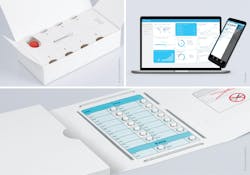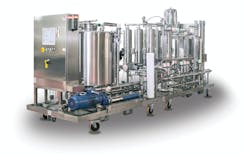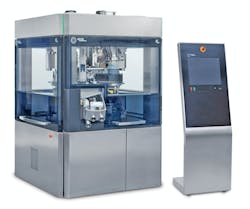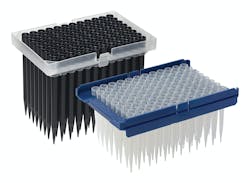It’s a cliché now, but when the curtain was tugged open at the end of “The Wizard of Oz” to reveal that the mighty Oz was really just a man pushing buttons and pulling levers, it marked one of the biggest surprises in cinematic history. And although the moment unveiled a shocking ruse, it also showcased the power technology can have when wielded in innovative ways.
Manufacturing vendors similarly play a vital role behind the curtain of the great and powerful pharma industry. Today, the gadgets are much more sophisticated than anything dreamed up in the land of Oz — with automation, robotics, remote monitoring and data analysis playing key roles in the innovations hitting the labs and plant floors of industry facilities.
The technologies also show that when it comes to getting drugs onto the market, manufacturing vendors are the true wizards of pharma.
For the ninth year, Pharma Manufacturing is paying homage to the equipment and solutions providers who help production in the industry hum along. This year in particular, the pressure has been on pharma to keep pace with the ongoing demand for pandemic products, while also meeting the needs of rapidly expanding areas of the industry, such as advanced therapeutics. Without innovations that boost speed and efficiency throughout the development process — from early drug creation to packaging and shipping — the industry would surely stumble on this journey.
Here, we proudly pull back the curtain on 19 recently launched or updated technologies selected by Pharma Manufacturing editors and reviewers for this year’s Pharma Innovation Awards.
Bioprocessing
The biopharma sector often steals the spotlight in the industry — with updates about vaccines, monoclonal antibodies, and cell and gene therapies grabbing headlines nearly every day. Biopharma is also in the midst of a major manufacturing expansion. Between 2020 and 2027, the biopharma sector is forecasted to swell at a CAGR of about 7.3% to $535 billion.1 The growth will be driven by an increase in the elderly population, a surge in chronic diseases as well as increased strategic collaboration between biopharma companies.
To stay in step with rising demand, our Pharma Innovation Award winners offer new and valuable tools to improve processes throughout the biopharma value chain.
Intensifying the process
Process intensification has emerged as a rising goal for biotech manufacturers in recent years because of how it can help a company shrink its facility footprint and lower costs. This year, Univercells Technologies introduced the NevoLine Upstream platform, an automated manufacturing solution for the high-performance production of viral vaccines, viral vectors and oncolytic viruses leveraging process intensification. Unlike large, stand-alone viral manufacturing units, the platform integrates, chains and automates production — from inoculation to midstream processing — into a compact module.
The three square-meter unit can be used in various configurations, offering flexibility in multi-product facilities. The chaining and continuous processing also allows end-to-end automation to deliver a concentrated, clarified bulk product. All told, the platform was designed to save space and reduce capital expenditures.
“The field needs this type of improvement,” a member of the Pharma Manufacturing edit board said of the NevoLine Upstream platform.
Enhanced smart pharma tools
For all of the promise therapeutic proteins and viral vectors hold in pharma, several manufacturing challenges remain in their production. The growth in demand for viral vectors in particular, which is estimated to swell by about 20% per year for the next five years,2 coupled with manufacturing bottlenecks and a slow supply, has led to shortages and long lead times throughout the industry.
With that challenge in mind, Solentim’s ICON was developed to help streamline and accelerate a critical step in therapeutic protein and viral vector manufacturing: single-cell cloning.
The clonality stage of manufacturing ensures that the process has been brought down to a single cell to limit variability within the cell bank. Using low-volume measurements of critical quality attributes, such as IgG titer, confluency, cell volume and viability of cell density, the ICON system enables rapid stratification of leading cell candidates. Developed as what the company calls the “world’s first” benchtop system that characterizes the high-productivity of clones in cell development, ICON works with Solentim’s data management system, STADIUS. Leveraging data-driven insights, the system is designed to save resources and speed the development of new cell-based therapies.
For further downstream production, Aizon’s Bioreactor Application SaaS combines almost all of what Pharma 4.0 has to offer — artificial intelligence, machine learning, cloud technologies, IIoT and other analytical tools — into what the company calls “the industry’s first predictive analytics and deep knowledge management application targeting bioreactors in GxP environments.”
Applicable to both batch and continuous operations, the turnkey application offers a wide range of insights for operators — from process discovery and batch comparison tools to real-time monitoring and yield prediction capabilities. Using the tools and dashboards within the app, operators are able to quickly analyze and visualize a number of process parameters in different batches and see how those parameters interact with each other.
With the help of digital tools that enable data-driven decision making, companies are able to use the Bioreactor Application to optimize processing.
Research and development
There’s a lot riding on the extensive R&D process in pharma. From identifying potential drugs to assessing their viability to ushering winning candidates into clinical trials, the R&D phase is time-consuming and critical to a drug’s eventual success.
Tools or solutions that streamline any of the steps in this long and arduous process — such as this year’s winners in the R&D category — can be a major boon for drug developers.
Accelerating drug discovery
Although ion mobility (IM) techniques have long been used in pharma research, ion loss and resolution limitations remain an ongoing hurdle with the method. Using high resolution ion mobility (HRIM), MOBIlLion Systems’ MOBIE mass spectrometer overcomes these challenges with separations that are achieved on 13-meter path lengths — 12 times higher than other technologies, according to the company — realized with serpentine electrode patterns on standard printed circuit board (PCB) technology. MOBIlLion says that the beauty of this approach to digitizing separations on PCBs is that it allows for virtually limitless path lengths, resulting in superior separation with molecules of interest.
The driving technology of MOBIE — Structures for Lossless Ion Manipulation (SLIM) — has become instrumental in allowing researchers to separate and identify molecular structures that wouldn’t be detected with many other established techniques. And with easy push-button software, MOBIE is designed to simplify workflows with faster separations of challenging analyte classes — an innovation that will accelerate the characterization of biotherapeutics, and biomarker identification and validation.
“[This technology] is a good method to focus analysis and save time,” a member of Pharma Manufacturing’s edit board said of MOBIE.
Enabling faster drug discovery was also the driving goal behind the development of Araceli Biosciences’ Endeavor high content analysis (HCA) platform. Combining advanced scanning hardware and AI software, the platform has the ability to generate high-resolution full-well results in 10 minutes and preliminary data in as little as 30 seconds — a feat the company says is “ground breaking,” exceeding the speed of any other HCA system on the market by six-fold.
The platform performs complicated work as it helps scientists quickly identify and potentially discard a range of drug candidate compounds — including small molecules or RNAi — based on their phenotypic effect at the cellular level. But with its Voyager software, Endeavor was also designed to be user-friendly, with a touchscreen and intuitive workflow. All together, Endeavor was developed to shrink the gap between discovery and commercialization by allowing faster decision-making in research.
Schreiner MediPharm
Smart Blister Packs and Smart Kit Boxes
Smarter clinical trials
Ensuring medication adherence is vital to the success of a clinical trial — and patients who fail to comply can undermine the results of the study. With so much at stake, it’s no surprise that all experts who provided feedback to Pharma Manufacturing on this year’s candidates voted unanimously to include a solution to this issue — Schreiner MediPharm’s Smart Blister Packs and Smart Kit Boxes — among the Pharma Innovation Awards.
With the help of AARDEX Group, an expert in digital medication adherence, Schreiner MediPharm developed the solution to bolster and ensure better compliance in clinical trials. Using sensor technology and smart medicine packaging, the technology provides real-time data when doses are taken (Smart Blister Packs are used for tablets and capsules, and Smart Kit Boxes for vials and syringes). The information is then automatically stored and sent to a database through an app that can be used on a smartphone.
In addition to enhancing confidence in clinical trial results, the solution also alerts users to structural deficiencies in the packs and generates critical information about patient behavior.
“Nicely done. These types of systems are the future in compliance for clinical dosage regimens,” a Pharma Manufacturing edit board member said of the Smart Blister Packs and Smart Kit Boxes.
Plant operations
Once manufacturing begins, the pressure is on to ensure consistent results through the various stages of processing — a challenge that is growing more predominant as the industry pivots towards a wider array of batch sizes and products.
With demand rising for a growing number of diverse pharma products, this year’s winners offer new ways to increase efficiency and lower costs while helping manufacturers stay nimble on their feet.
Boosting efficiency through automation
With the goal of improving batch consistency and quality in pharma processing, Aspen Technology’s PAT portfolio now combines several technologies for product and process modeling, analysis and optimization — Aspen Unscrambler, Aspen Process Pulse and Aspen ProMV. The newly combined suite uses the best of these technologies to create a powerful continuous improvement suite that can be used in large-scale production for a number of pharma products, including small molecules and biopharmaceuticals.
The benefits of the suite include real-time product and process quality monitoring that combines information from traditional process sensors and advanced spectroscopic sensors; accurate batch end-point determination; batch-to-batch quality and yield trend analysis and optimization; and in-line quality testing to enable real-time release.
With these various functions under a single suite, the PAT portfolio is designed to automate workflows, enhance diagnostics capabilities and optimize outcomes for operations personnel. This drives more consistent in-spec production, higher yields and greater throughput, all helping to alleviate supply chain pressures by delivering more saleable product every day.
BEA Technologies
MAGNEXFLO
Combining capabilities is also a key feature of BEA Technologies’ MAGNEXFLO, a fully automated filtration unit. By pooling three filtration stages into one skid unit, the solution saves space while maintaining efficiency for many demanding products, such as raw gelatins and viscous fluids, that need to be clarified.
MAGNEXFLO leverages the company’s MAGNEX filter element, which can retain a large amount of impurities and colloidal particles. The new unit is customizable with several options for filtration elements available to meet different production needs. It also provides direct filtration, without the need to recirculate products.
Ultimately, the company says that the system lowers cost compared to other options on the market.
Next-gen tableting
Avoiding contamination is a major priority in tablet production, especially when manufacturers are working with multiple products. Thus, containment remains a chief concern when assessing tablet presses.
Fette Compacting
F30i
Fette Compacting’s new F30i double rotary tablet press satisfies containment concerns — while operating at high speeds. Released this year as a follow-up to the company’s F10i single rotary press for small batches, the F30i is designed for large-scale production with the ability to crank out 1.6 million tablets per hour. The unit’s dust-tight design also protects operators from contamination by keeping dust from being released from the machine. And despite its updates, the unit’s cross-generation system capability also allows die and turret rotors to be adopted from earlier models.
In addition, the unit comes with various Pharma 4.0 bells and whistles including open interfaces that comply with automation standards and can be integrated with IoT and manufacturing execution systems.
Monitoring and analytical devices
Failing to accurately monitor the many variables at play during pharma processing can result in costly problems such as contamination. Ideally, monitoring devices should work easily, quickly and effectively to help companies stay on top of conditions inside manufacturing environments.
This year’s Pharma Innovation Awards winners represent impactful step changes in the field for monitoring and analytical devices.
Hamilton Bonaduz AG's
CO2NTROL
A better CO2 sensor
Dissolved carbon-dioxide (DCO2) in biopharma applications is traditionally monitored by means of indirect pH measurement (Severinghaus technology) — requiring operators to wrestle with product calibration, maintenance and multiple sources of drift. On top of that, the embedded pH sensor has to be replaced quite often. To simplify the process, Hamilton Bonaduz AG’s CO2NTROL solid-state sensor directly identifies DCO2 levels using a novel optical approach. Once CO2 molecules are diffused into a gas permeable membrane, the instrument measures the absorption of CO2-specific mid-infrared region wavelengths, which directly correlates to the partial pressure of CO2 in the sample (liquid or gas).
The result is a measurement that is more accurate and maintenance-free — no replacement parts — than traditional sensors, enabling real-time, automated control of CO2. The improvements also ensure batch-to-batch reproducibility, lower costs and increase consistency throughout processing — from R&D to large-scale production.
“A more reliable CO2 sensor is welcome. This seems like a real step forward,” a Pharma Manufacturing edit board member noted.
Enhanced particulate measurements
The regulatory requirements for operating cleanroom environments are continuously becoming more strict. To stay compliant, drugmakers need the most up-to-date monitoring technologies.
Particle Measuring Systems’ IsoAir Pro-E Remote Particle Counter was developed to provide a superior level of continuous particle measurement in environmentally controlled spaces. With its 316L stainless steel enclosure design, the particle counter incorporates several leading-edge monitoring technologies into a single instrument.
According to the company, the instrument is the first ever with a built-in vacuum designed for use with the vaporized hydrogen peroxide process. In addition, it is powered by Power over Ethernet and features an internal blower that minimizes the need for external connections and supporting equipment. By integrating into a variety of software systems and featuring a quick release mounting bracket that stores essential sensor data, the instrument also provides enhanced data management.
Put together, the instrument ensures a more complete particle measurement solution for small- or large-scale pharmaceutical and biomanufacturing environments.
Quality control
From a patient’s point of view, the quality of pharma products should be a given, and drugs should only serve to improve health — never to harm it. From a manufacturer’s viewpoint, achieving high quality is the result of painstaking processes that ensure the safety, consistency and compliance of products.
But when done right, quality-related innovations, such as this year’s winners, can go beyond regulatory compliance to improve commercial performance while helping companies achieve other critical business goals.
Holistic quality management
A quality-by-design approach to manufacturing goes hand-in-hand with strategic business practices. Optimal Industrial Technologies’ synTQ 5.5 provides both regulatory quality compliance and business insights, from R&D through to manufacturing.
A vendor-agnostic, PAT knowledge management and quality-centric software suite, the company says that the synTQ was the “first product of its type on the marketplace.”
By providing a holistic and data-driven overview of various phases of manufacturing, the solution utilizes interconnected tools, sensors and systems to provide real-time insights on quality parameters. The solution thus offers full visibility and control over manufacturing to address current and future production needs.
The latest version of the system also integrates orchestration digital twin functionalities for partial or complete PAT methods virtually, which allows companies to create and test process data flows before applying new manufacturing activities in real-world settings.
Animal-free BET testing
Horseshoe crabs have long been an integral part of creating the bacterial endotoxins test (BET) — also known as limulus amebocyte lysate (LAL) tests — that are required for injectable drugs like vaccines. But the process of making the test involves bleeding horseshoe crabs, which is an unsustainable method for the long term.
Now the Associates of Cape Cod’s PyroSmart NextGen provides a recombinant LAL reagent that is sustainable and animal-free. Designed for end-product testing of human and animal injectable drugs and medical devices, the PyroSmart NextGen uses the same enzymatic cascade pathway as traditional methods and provides results that are just as consistent and high quality. It can directly replace naturally sourced reagents without the need to purchase new equipment or instruments.
The reagent can be used for a variety of endotoxin tests — from water sampling to studies that require high sensitivity, such as intrathecal products or those requiring high dilutions to overcome interference. It also provides a number of other benefits over competing animal-free options, including single step reconstitution and the ability to perform kinetic assays.
Packaging
With the pandemic ramping up demand throughout pharma, the pressure has been on to ensure that bottlenecks don’t slow down progress. On the packaging line that means that systems have to work quickly and accurately. It’s no simple task — the pipeline for pharma products is becoming ever-more complex as newer and smaller batches of advanced therapies make their way through production lines. Thus, packaging systems have to also be flexible.
This year’s winners showcase packaging innovations that balance speed and complexity to help deliver critical medicines to patients.
Mettler-Toledo
FlashCell
Faster checkweighing
Across the industry, the leading checkweigher systems operate at about 700 ppm when working with lightweight blister packs. But this year, Mettler-Toledo’s FlashCell load cell for Mettler-Toledo checkweighers moved the goal on what’s possible with a checkweigher system by hitting 800 ppm.
FlashCell allows the checkweighers to reach these new speeds without sacrificing accuracy. According to Mettler-Toledo, the checkweigher works with regulation-compliant precision. In fact, its weigher is so sensitive that it can detect if even one drug leaflet or filled syringe is missing from a load.
As an added bonus, Mettler-Toledo checkweighers with FlashCell load cells also have a smaller footprint. Because the unit works with shorter measuring times at high speeds, the weighing conveyor can be reduced in length. This shorter conveyor also moves slower, which boosts product handling stability, and feeds into a shorter product collection area. Overall, these reductions in conveyor length can shrink the size of the unit by 24%.
Dual shipping capabilities
An increasing number of pharma products that require ultracold storage are entering the market, adding new challenges to shipping. This year, Packaging Technology Group’s TRUEtemp Naturals Dual Temperature Packaging Solution emerged as an innovative new option to handling different therapies in one shipment.
With its thermal design, drug products that need to be stored at different temperatures — often one is frozen while the other is refrigerated — can be shipped in the same container. The shipper could be particularly useful for shipments of immunotherapies for certain cancers and other illnesses.
On top of that, the shippers are made with 100% curbside recyclable and repulpable materials. With sustainability as a top priority for many companies, the shippers were designed to help drugmakers meet corporate sustainability goals while simplifying shipping.
Stevanato Group
Vision Robot Inspection Machine
Robotic inspections
In factories of the future, robots will largely take over many of the more menial and redundant tasks. The goal, however, isn’t to simply replace humans — it’s to combine human-like flexibility with machine learning capabilities.
Stevanato Group’s Vision Robot Unit Inspection Machine achieves both as a fully automated, highly accurate and flexible inspection system with AI technology. Capable of handling a variety of high-value pharma products — including mAbs, vaccines and lyophilized drugs — the unit can react quickly to changing product characteristics even throughout a single batch. It also learns continuously from both product and operator stimuli, resulting in a system that ultimately reduces the number of false rejects and false positives.
The system is also modular and can be customized for different environments — from labs to small scale production. Its customizability also ensures that the system is optimized for a company’s specific production needs, which enhances efficiency and speed.
Labs
With the market for advanced therapies swelling and demand in pharma ramped up due to the pandemic, the life sciences sector is undergoing a major boom. This growth has triggered spiking demand for lab space. In 2020, the industry was set to deliver 4.5 million square feet of new life sciences space — more than double the prior five-year average.3
As the pressure mounts to develop increasingly complex therapies at a fast clip in expanding lab spaces, innovative solutions that were once focused on the plant floor — such as lean operations, robotics and automation — are now making their way into labs as well.
A fully integrated lab
In many pharma companies, lab operations have often been performed in isolated sub-units or clusters. But with the growing emphasis on the importance of lab success, a need has emerged for an open, flexible layout with operations that are more fully transparent throughout the company.
To meet this need, Integrated Project Services launched iLAB - Intelligent Lean Lab, a fully digital process dashboard that seeks to break down the silos of lab work. Based on the concepts of lean, flexible and process-based operations, the software platform is unique in its ability to integrate personnel, space, bench, equipment and project schedules into one solution.
After implementation, the solution offers a data-driven view of lab operations that allows for easy monitoring throughout the company. It also allows various lab professionals to develop supply chain mapping under a digital umbrella that includes orders for a host of essential lab products such as raw materials, equipment and more. It uses lean tools for lab programming, educates lab staff on lean and automation principles, and leverages process mapping at the facility and individual lab level.
Overall, the company says that iLAB offers a holistic view of lab operations to improve efficiency.
Precise robotic tips for liquid handling
Minimizing downtime and ensuring reliable results are essential for lab operations. At research workstations, automated robotics can help minimize stumbles in workflow — as long as the components function efficiently.
Avantor
J.T.Baker Robotic Tips
J.T.Baker Robotic Tips from Avantor are designed with precision in mind. Engineered to help scientists move from discovery to delivery faster, the robotic tips feature a straighter tip for low rejection and less breakage when used in robotic liquid handling systems.
The tips are ideal for a range of applications — from genomics and cell biology to proteomic workflows — and are able to accurately dose small volumes.
In addition, the robotic tips are manufactured for compliance in even the strictest environments. According to the company, the tips are produced on a fully automated line under cleanroom conditions, and are untouched by human hands.
The transparency feature of the tips also enables easier visual inspection while delivering reliable results for dynamic lab needs.
Automated sample prep
Sample preparations are one of the largest potential bottlenecks in the lab and the process eats up a large amount of time for lab techs. Now, accroma labtec’s SamplePrep has transformed this longstanding challenge into a fully automated and precisely documented process.
According to the company, the new system automates full sample preparation for solid samples —from weighing to the transfer into high-performance liquid chromatography. The result is a simple, sample in/answer out system that reduces the time spent on the process.
The system can also prepare samples for different workflows at the same time, while allowing users unlimited possibilities for combining different steps including weighing, shaking, dispensing, pipetting, filtering and more.
By automating the process, the system reduces data variability, personnel costs and quality control concerns.
And that’s it for the 2021 Pharma Innovation Award winners — impactful technologies that were unveiled this year for pharma manufacturing. Thank you so much to all of the companies that submitted entries to this year’s awards. And thank you to all the vendors that work tirelessly towards the goal of making pharma a better industry.
References
- Acumen Research and Consulting. “Biopharmaceutical Market – Global Industry Analysis, Market Size, Opportunities and Forecast, 2020-2027.” March 30, 2021.
- Peter Walters. “Engineering Angles: Countering the viral vector shortage.” Pharma Manufacturing. February, 2020.
- Newmark Knight Frank. “COVID-19 and the Future of the Life Sciences Sector.” May 2020.













